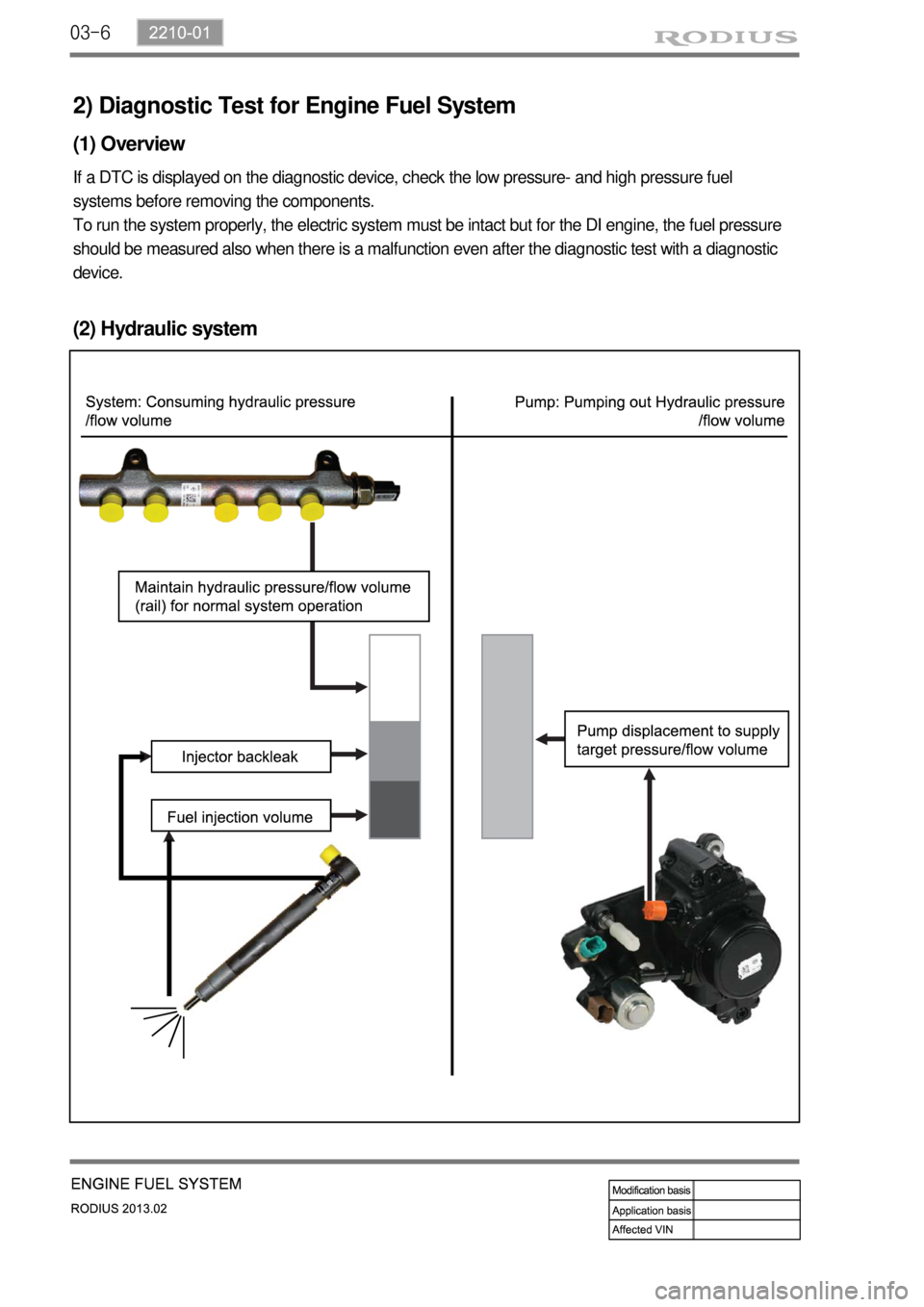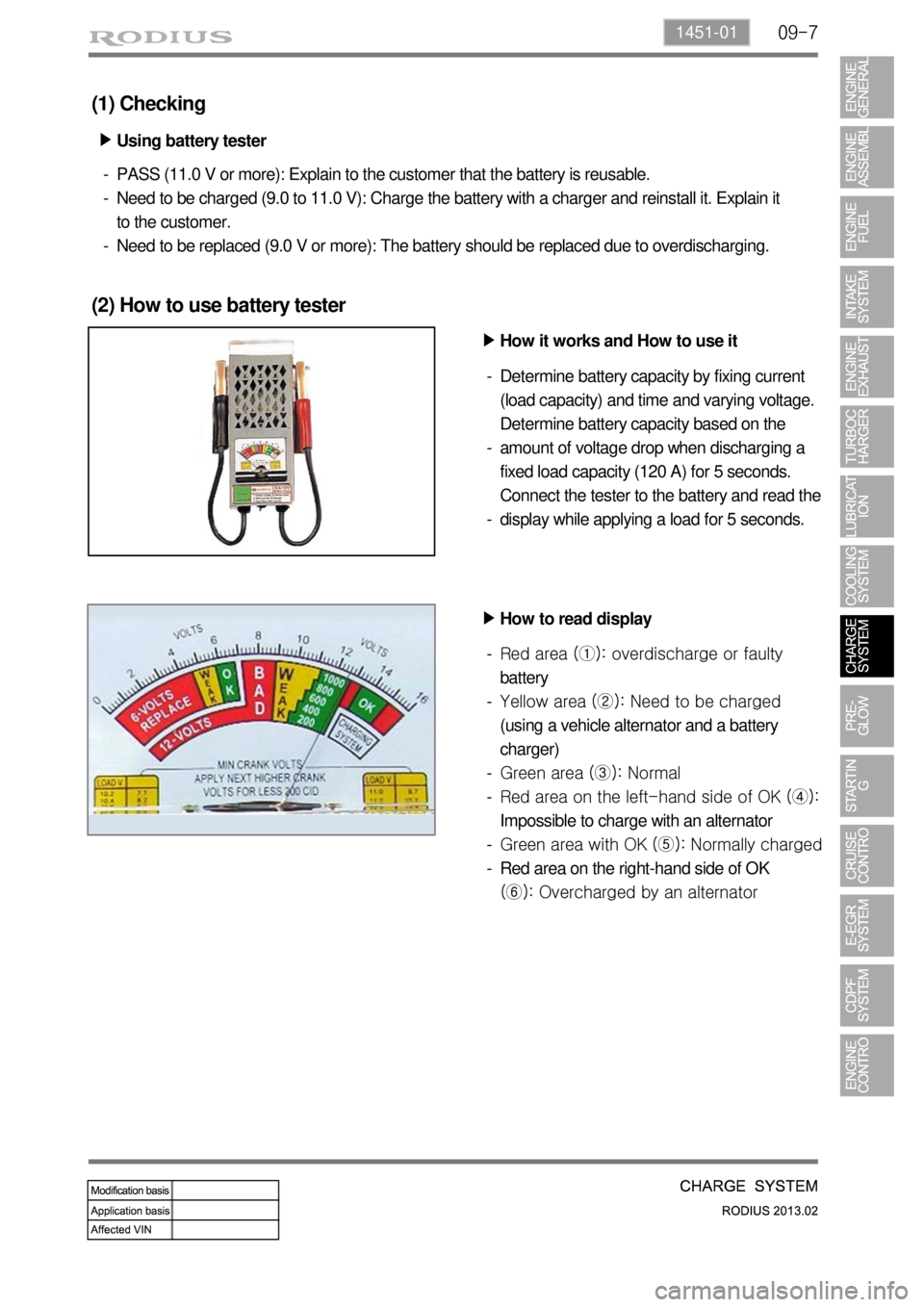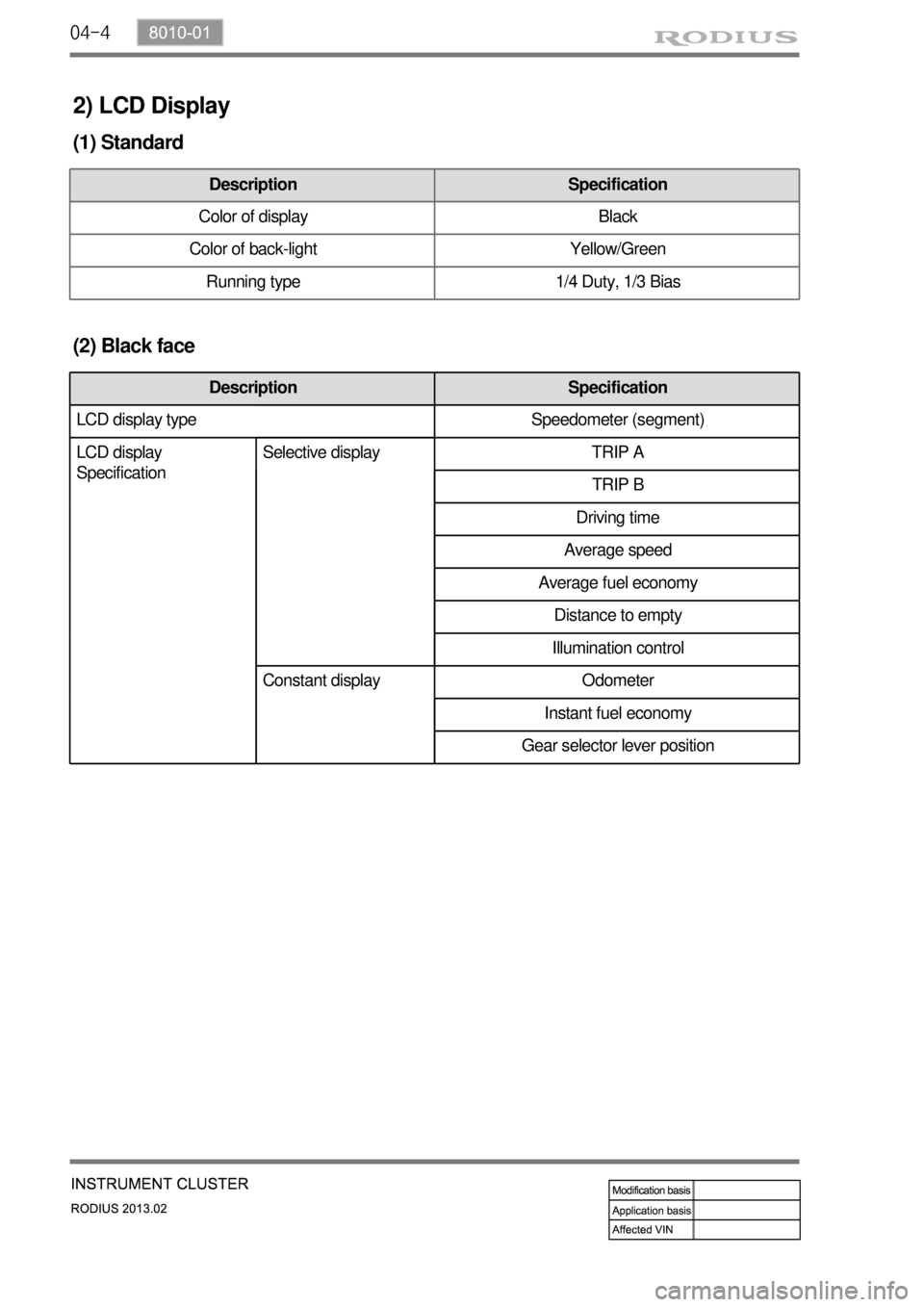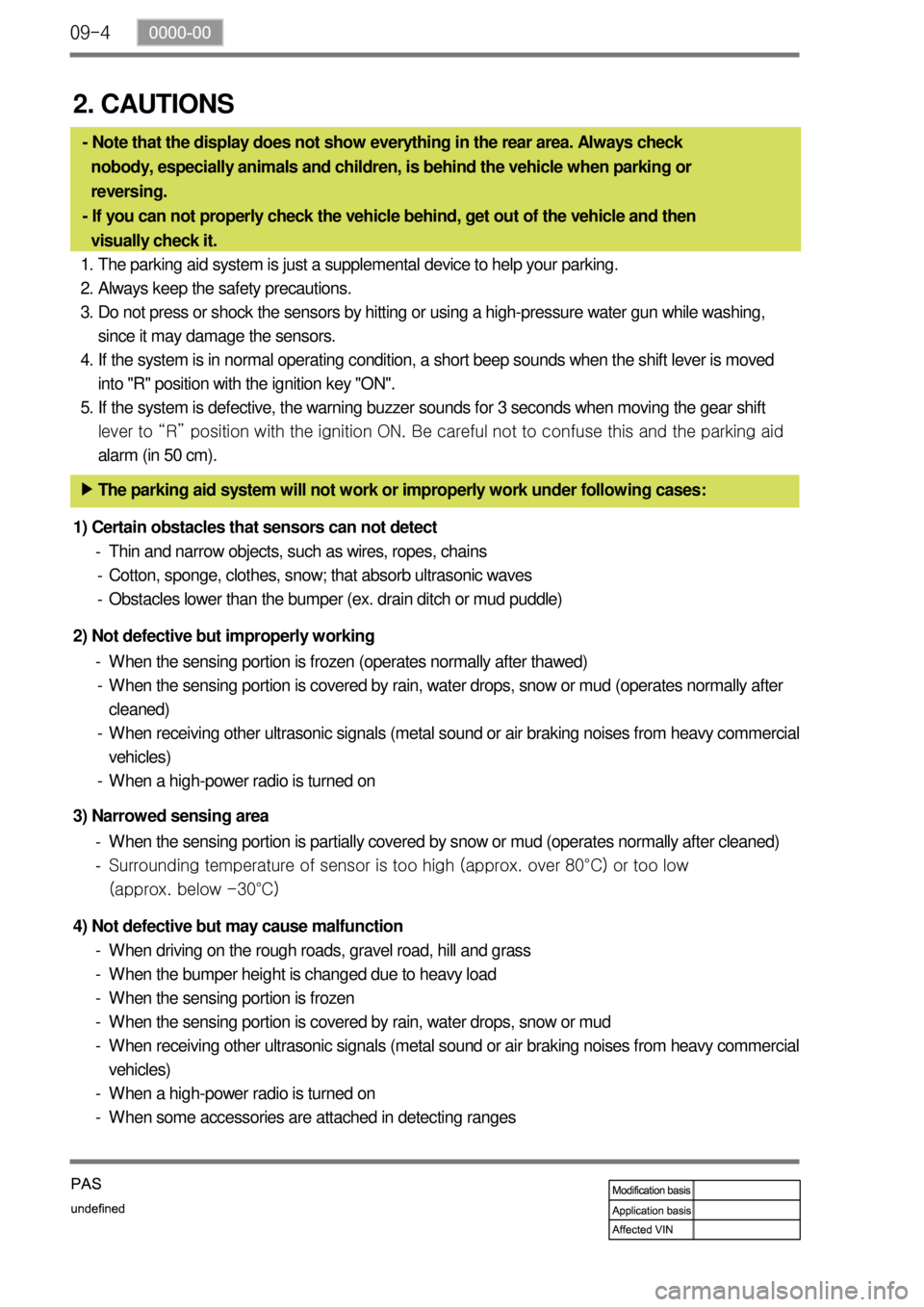display SSANGYONG TURISMO 2013 Service Manual
[x] Cancel search | Manufacturer: SSANGYONG, Model Year: 2013, Model line: TURISMO, Model: SSANGYONG TURISMO 2013Pages: 796, PDF Size: 78.99 MB
Page 213 of 796

03-6
2) Diagnostic Test for Engine Fuel System
(1) Overview
If a DTC is displayed on the diagnostic device, check the low pressure- and high pressure fuel
systems before removing the components.
To run the system properly, the electric system must be intact but for the DI engine, the fuel pressure
should be measured also when there is a malfunction even after the diagnostic test with a diagnostic
device.
(2) Hydraulic system
Page 219 of 796

03-12
(5) High Pressure System Pressure Test
Fuel rail pressure test ▶
Disconnect the pressure sensor connector
(A) and IMV connector (B) from the fuel rail. 1.
Connect the pressure tester to the fuel rail
pressure sensor connector. 2.
Crank the engine 2 times for 5 seconds.
3.
Read the highest pressure value displayed
on the tester display.
If the highest pressure value is 1,050 bar
or less, refer to the section "Fuel System
Check Process". -
-
Page 220 of 796

03-132210-01
How To Use Pressure Tester ▶
Press the "TEST" button on the tester to
check if the message "TEST?" is displayed.
If the button is pressed again at 4 seconds
after starting engine cranking, the highest
pressure is displayed on the tester. 1.
2.
The fuel rail pressure value can be checked using a diagnostic device.
Page 224 of 796

03-172210-01
HP pump pressure test ▶
Prepare a special tool for high pressure test
and clean it thoroughly to prevent foreign
materials from entering. 1.
Disconnect the high pressure fuel supply pipe
on the HP pump and install the close rail in the
tool kit. 2.
Connect the other end of the close rail to the
fuel rail for test. 3.
Disconnect the return hose for HP pump and
connect the clear hose and connect its the
other end to the return port of the fuel rail for
test. 4.
Connect the digital tester connector to the
sensor connector of the fuel rail for test.
Crank the engine 2 times for 5 seconds after
removing the IMV connector and fuel rail
pressure sensor connector.
Read the pressure value displayed on the
tester display is within the specified. 5.
6.
7.
Specification1,050 bar or more
Page 283 of 796

09-71451-01
(1) Checking
Using battery tester ▶
PASS (11.0 V or more): Explain to the customer that the battery is reusable.
Need to be charged (9.0 to 11.0 V): Charge the battery with a charger and reinstall it. Explain it
to the customer.
Need to be replaced (9.0 V or more): The battery should be replaced due to overdischarging. -
-
-
(2) How to use battery tester
How it works and How to use it ▶
Determine battery capacity by fixing current
(load capacity) and time and varying voltage.
Determine battery capacity based on the
amount of voltage drop when discharging a
fixed load capacity (120 A) for 5 seconds.
Connect the tester to the battery and read the
display while applying a load for 5 seconds. -
-
-
How to read display ▶
Red area (①): overdischarge or faulty
battery
Yellow area (②): Need to be charged
(using a vehicle alternator and a battery
charger)
Green area (③): Normal
Red area on the left-hand side of OK (④):
Impossible to charge with an alternator
Green area with OK (⑤): Normally charged
Red area on the right-hand side of OK
(⑥): Overcharged by an alternator -
-
-
-
-
-
Page 406 of 796

09-31522-16
1. ENGINE DATA DISPLAY TABLE
Page 452 of 796

02-218710-01
4) Door Ajar Warning
The warning light in indicator display comes on when opening any of driver’s door,
passenger’s door, rear door or tailgate while the vehicle speed is below 6 km/h (V1).
The warning light goes off when closing the door under step 1.
The warning light blinks when the vehicle speed is over 10 km/h (V1) for more than 2 seconds while
the warning light is turned on.
The warning light blinks when a door is opened while the vehicle speed is over 10 km/h (V1) (while
the warning light is turned off).
The warning light goes off when closing the door under step 3.
The warning light comes on when the vehicle speed is below 3 km/h (V2) under step 3. 1.
2.
3.
4.
5.
6.
Page 453 of 796

02-22
5) Seat Belt Warning
The seat belt warning light comes on and the chime buzzer in the ICM box sounds for 6 seconds
when turning the ignition key to “ON” from “OFF”. If the seat belt is fastened before turning
the ignition key to “ON” position, the warning light in the indicator display blinks for 6
seconds, however, the chime buzzer does not sound.
The seat belt warning light goes off and the chime buzzer in the ICM box stops when turning the
ignition switch to “OFF” position.
The chime buzzer stops and the seat belt warning light stays on for the specified duration (6
seconds) when fastening the seat belt during the warning operation.
The seat belt warning light comes on and the chime buzzer sounds for 6 seconds again when
unfastening the seat belt during fastening operation. 1.
2.
3.
4.
Page 486 of 796

04-4
2) LCD Display
Description Specification
Color of display Black
Color of back-light Yellow/Green
Running type 1/4 Duty, 1/3 Bias
(1) Standard
(2) Black face
Description Specification
LCD display type Speedometer (segment)
LCD display
SpecificationSelective display TRIP A
TRIP B
Driving time
Average speed
Average fuel economy
Distance to empty
Illumination control
Constant display Odometer
Instant fuel economy
Gear selector lever position
Page 531 of 796

09-4
2. CAUTIONS
The parking aid system is just a supplemental device to help your parking.
Always keep the safety precautions.
Do not press or shock the sensors by hitting or using a high-pressure water gun while washing,
since it may damage the sensors.
If the system is in normal operating condition, a short beep sounds when the shift lever is moved
into "R" position with the ignition key "ON".
If the system is defective, the warning buzzer sounds for 3 seconds when moving the gear shift
lever to “R” position with the ignition ON. Be careful not to confuse this and the parking aid
alarm (in 50 cm). 1.
2.
3.
4.
5.
- Note that the display does not show everything in the rear area. Always check
nobody, especially animals and children, is behind the vehicle when parking or
reversing.
- If you can not properly check the vehicle behind, get out of the vehicle and then
visually check it.
The parking aid system will not work or improperly work under following cases: ▶
1) Certain obstacles that sensors can not detect
Thin and narrow objects, such as wires, ropes, chains
Cotton, sponge, clothes, snow; that absorb ultrasonic waves
Obstacles lower than the bumper (ex. drain ditch or mud puddle) -
-
-
2) Not defective but improperly working
When the sensing portion is frozen (operates normally after thawed)
When the sensing portion is covered by rain, water drops, snow or mud (operates normally after
cleaned)
When receiving other ultrasonic signals (metal sound or air braking noises from heavy commercial
vehicles)
When a high-power radio is turned on -
-
-
-
3) Narrowed sensing area
When the sensing portion is partially covered by snow or mud (operates normally after cleaned)
Surrounding temperature of sensor is too high (approx. over 80°C) or too low
(approx. below -30°C) -
-
4) Not defective but may cause malfunction
When driving on the rough roads, gravel road, hill and grass
When the bumper height is changed due to heavy load
When the sensing portion is frozen
When the sensing portion is covered by rain, water drops, snow or mud
When receiving other ultrasonic signals (metal sound or air braking noises from heavy commercial
vehicles)
When a high-power radio is turned on
When some accessories are attached in detecting ranges -
-
-
-
-
-
-